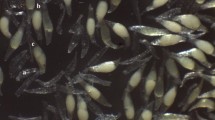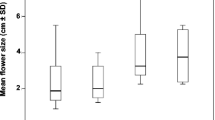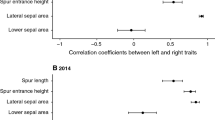Abstract
Apocarpous flowers share opportunities for post-fertilization ovule selection among more functional levels than syncarpous flowers, because the occurrence of a variable number of unfused carpels adds a new source of variation to the likelihood of successful female reproduction. The extent to which post-fertilization events might differ among these unfused carpels may promote variations in the reproductive strategies of plants. We report a study of the variation, within and among carpels and flowers, in seed production and mass in the apocarpous Helleborus foetidus (Ranunculaceae), in relation to the number of carpels per flower. Differences within and among carpels in female reproductive success were affected by carpel number and pollination environment. When analysing whole flowers as functional units we also found that the magnitude of the differences related to carpel number and pollination treatment actually depended on the “distribution” of pollen types within flowers. Thus, variable within-flower pollination environments, more likely to occur in apocarpous than in syncarpous flowers, may affect the strategies of resource allocation for fruit development at different stages of the reproductive process. Regarding seed production, we found that producing more flowers with four carpels was under directional; however, when mean diaspore mass was considered as a measure of fitness, directional selection was found on producing flowers with two and three carpels (the modal carpel number found in wild populations). We discuss ecological and developmental reasons which could explain the observed pattern, and conclude that selection on an optimum carpel number may be very variable across the species range, as the discussed reasons may impose constraints on eventual evolutionary response, thus contributing to the maintenance of the intra-individual variability in carpel number.



Similar content being viewed by others
References
Acosta FJ, Delgado JA, Lopez F, Serrano JM (1997) Functional features and ontogenetic changes in reproductive allocation and partitioning strategies of plant modules. Pl Ecol 132:71–76
Arathi HS, Ganeshaiah KN, Uma Shaanker R, Hedge SG (1999) Seed abortion in Pongamia pinnata (Fabaceae). Am J Bot 86:659–662
Armbruster WS, Gobeille Rogers D (2004) Does pollen competition reduce the cost of inbreeding? Am J Bot 91:1939–1943
Armbruster WS, Debevec EM, Willson MF (2002) Evolution of syncarpy in angiosperms: theoretical and phylogenetic analyses of the effects of carpel fusion on offspring quantity and quality. J Evol Biol 15:657–672
Arnold SJ, Wade MJ (1984) On the measurement of natural and sexual selection: theory. Evolution 38:709–719
Bañuelos MJ, Obeso JR (2003) Maternal provisioning, sibling rivalry and seed mass variability in the dioecious shrub Rhamnus alpinus. Evol Ecol 17:19–31
Bates DM (2005) Fitting linear mixed models in R. R News 5:27–30
Bates DM, Maechler M (2009) lme4: linear mixed-effects models using S4 classes. R package version 0.999375-32. http://CRAN.R-project.org/package=lme4
Burd M (1998) “Excess” flower production and selective fruit abortion: a model of potential benefits. Ecology 79:2123–2132
Canty A, Ripley B (2009) Boot: Bootstrap R (S-Plus) functions. R package version 1.2-41
Carr SGM, Carr DJ (1961) The functional significance of syncarpy. Phytomorphology 11:249–256
Castellanos MC, Medrano M, Herrera CM (2008) Subindividual variation and genetic versus environmental effects on seed traits in a European Aquilegia. Botany 86:1125–1132
Castro J (1999) Seed mass versus seedling performance in Scots pine: a maternally dependent trait. New Phytol 144:153–161
Cooke TJ (2006) Do Fibonacci numbers reveal the involvement of geometrical imperatives or biological interactions in phyllotaxis? Bot J Linn Soc 150:3–24
Craine JM (2005) Reconciling plant strategy theories of Grime and Tilman. J Ecol 93:1041–1052
Davidson AC, Hinkley DV (1997) Bootstrap methods and their applications. Cambridge University Press, Cambridge
Ehrlen J (1991) Why do plants produce surplus flowers? A reserve-ovary model. Am Nat 138:918–933
Ehrlen J (1993) Ultimate functions of non-fruiting flowers in Lathyrus vernus. Oikos 68: 45–52
Endress PK (1982) Syncarpy and alternative modes of scaping disadvantages of apocarpy in primitive angiosperms. Taxon 31:48–52
Endress PK (1987) Floral phyllotaxis and floral evolution. Bot Jahrb Syst Pflanzengesch Pflanzengeogr 108:417–438
Endress PK, Doyle JA (2007) Floral phyllotaxis in basal angiosperms: development and evolution. Curr Opin Plant Biol 10:52–57
Fedriani JM, Rey PJ, Garrido JL, Guitián J, Herrera CM, Medrano M, Sánchez-Lafuente AM, Cerdá X (2004) Geographical variation in the potential of mice to constrain an ant-seed dispersal mutualism. Oikos 105:181–191
Garrido JL (2003) Semillas y plántulas de Helleborus foetidus L. (Ranunculaceae): variación geográfica, ecología y Evolución. Dissertation, Universidad de Jaén, Jaén, Spain
Garrido JL, Rey PJ, Cerdá X, Herrera CM (2002) Geographical variation in diaspore traits of an ant-dispersed plant (Helleborus foetidus): are ant community composition and diaspore traits correlated? J Ecol 90:446–455
Garrido JL, Rey PJ, Herrera CM (2005) Fuentes de variación en el tamaño de la semilla de la herbácea perenne Helleborus foetidus L (Ranunculaceae). An J Bot Mad 62:115–125
Guitián J, Medrano M, Herrera CM, Sánchez-Lafuente AM (2003) Variation in structural gender in the hermaphrodite Helleborus foetidus (Ranunculaceae): within and among-population patterns. Pl Syst Evol 241:139–151
Herrera CM (1991) Dissecting factors responsible for individual variation in plant fecundity. Ecology 72:1448–1463
Herrera CM (2000) Flower-to-seedling consequences of different pollination regimes in an insect-pollinated shrub. Ecology 81:15–29
Herrera CM (2002) Censusing natural microgametophyte populations: variable spatial mosaics and extreme fine-graininess in winter-flowering Helleborus foetidus L (Ranunculaceae). Am J Bot 89:1570–1578
Herrera CM (2005) Post-floral perianth functionality: contribution of persistent sepals to seed development in Helleborus foetidus (Ranunculaceae). Am J Bot 92:1486–1491
Herrera CM, Sánchez-Lafuente AM, Medrano M, Guitián J, Cerdá X, Rey PJ (2001) Geographical variation in autonomous self-pollination levels unrelated to pollinator service in Helleborus foetidus (Ranunculaceae). Am J Bot 88:1025–1032
Herrera CM, Medrano M, Rey PJ, Sanchez-Lafuente AM, Garcia MB, Guitian J, Manzaneda AJ (2002) Interaction of pollinators and herbivores on plant fitness suggests a pathway for correlated evolution of mutualism- and antagonism-related traits. PNAS 99:16823–16828
Hossaert M, Valero M (1988) Effect of ovule position in the pod on patterns of seed formation in two species of Lathyrus (Leguminosae: Papilionoideae). Am J Bot 75:1714–1731
Huang SQ (2003) Reproductive success by unusual growth of pollen tubes to ovules. New Phytol 158:232–234
Klinkhamer PGL, de Jong TJ (1993) Phenotypic gender in plants: effects of plant size and environment on allocation to seeds in Cynoglossum officinale. Oikos 67:81–86
Klinkhamer PGL, Meelis E, de Jong TJ, Weiner J (1992) On the analysis of size-dependent reproductive output in plants. Funct Ecol 6:308–316
Lande R, Arnold SJ (1983) The measurement of selection on correlated characters. Evolution 37:1210–1226
Lemon J (2006) Plotrix: a package in the red light district of R. R-News 6:8–12
Luzuriaga AL, Escudero A, Pérez-Garcia F (2006) Environmental maternal effects on seed morphology and germination in Sinapis arvensis (Cruciferae). Weed Res 46:163–174
Mark S, Olesen JM (1996) Importance of elaiosome size to removal of ant-dispersed seeds. Oecologia 107:95–101
Marshall DL, Ellstrand C (1986) Sexual selection in Raphanus sativus: experimental data on non-random fertilization, maternal choice and consequences of multiple paternity. Am Nat 131:739–756
Marshall DL, Folsom MW (1991) Mate choice in plants: an anatomical to population perspective. Annu Rev Ecol Syst 22:37–63
Mazer SJ, Snow AA, Stanton ML (1986) Fertilization dynamics and parental effects upon fruit development in Raphanus raphanistrum: consequences for seed size variation. Am J Bot 73:500–511
Mena-Ali JI, Rocha OJ (2005) Effect of ovule position within the pod on the probability of seed production in Bauhinia ungulata (Fabaceae). Ann Bot 95:449–455
Mustajarvi K, Siikamaki P, Rytkonen S, Lammi A (2001) Consequences of plant population size and density for plant–pollinator interactions and plant performance. J Ecol 89:80–87
Niesenbaum RA, Casper BB (1994) Pollen tube numbers and selective fruit maturation in Lindera benzoin. Am Nat 144:184–191
Padien DJ, Lajtha K (1992) Plant spatial pattern and nutrient distribution in pinyon-juniper woodlands along an elevational gradient in northern New-Mexico. Int J Pl Sci 153:425–433
Pinheiro JC, Bates DM (2000) Mixed-effects models in S and S-PLUS. Springer, New York
Pinheiro JC, Bates DM, DebRoy S, Sarkar D, R Core team (2009). nlme: linear and nonlinear mixed effects models. R package version 3.1-96
Quesada M, Winsor JA, Stephenson AG (1993) Effects of pollen competition on progeny performance in a heterozygous cucurbit. Am Nat 142:694–706
R Development Core Team (2010) R: a language and environment for statistical computing. R Foundation for Statistical Computing, Vienna, Austria. ISBN 3-900051-07-0. http://www.R-project.org
Ramírez JM, Rey PJ, Alcántara JM, Sánchez-Lafuente AM (2006) Altitude and woody cover control recruitment of Helleborus foetidus in a Mediterranean mountain area. Ecography 29:375–384
Rey PJ, Ramírez JM, Sánchez-Lafuente AM (2006a) Seed- vs. microsite-limited recruitment in a myrmecochorous herb. Plant Ecol 184:213–222
Rey PJ, Herrera CM, Guitian J, Cerdá X, Sánchez-Lafuente AM, Medrano M, Garrido JL (2006b) The geographic mosaic of predispersal interactions and selection on Helleborus foetidus (Ranunculaceae). J Evol Biol 19:21–34
Rigney LP (1995) Postfertilization causes of differential success of pollen donors in Erythronium grandiflorum (Liliaceae): nonrandom ovule abortion. Am J Bot 82:578–584
Rocha OJ, Stephenson AG (1990) Effect of ovule position on seed production, seed weight, and progeny performance in Phaseolus coccineus (Leguminosae). Am J Bot 77:1320–1329
Sakai S (2007) A new hypothesis for the evolution of overproduction of ovules: an advantage of selective abortion for females not associated with variation in genetic quality of the resulting seeds. Evolution 61:984–993
Salopek-Sondi B, Kovac M, Ljubesic N, Magnus V (2000) Fruit initiation in Helleborus niger L. triggers chloroplast formation and photosynthesis in the perianth. J Plant Phys 157:357–364
Sánchez-Lafuente AM, Parra R (2009) Implications of a long-term, pollinator-mediated selection on floral traits in a generalist herb. Ann Bot 104:689–701
Sánchez-Lafuente AM, Guitian J, Medrano M, Herrera CM, Rey PJ, Cerda X (2005) Plant traits, environmental factors, and pollinator visitation in winter-flowering Helleborus foetidus (Ranunculaceae). Ann Bot 96:845–852
Shaw RG, Waser NM (1994) Quantitative genetic interpretation of postpollination reproductive traits in plants. Am Nat 143:617–635
Snow AA, Spira TP (1996) Pollen-tube competition and male fitness in Hibiscus moscheutos. Evolution 50:1866–1870
Susko DJ (2006) Effect of ovule position on patterns of seed maturation and abortion in Robinia pseudoacacia (Fabaceae). Can J Bot 84:1259–1265
Susko DJ, Lovett-Doust L (1999) Effects of resource availability, and fruit and ovule position on components of fecundity in Alliaria petiolata (Brassicaceae). New Phytol 144:295–306
Susko DJ, Lovett-Doust L (2000) Patterns of seed mass variation and their effects on seedling traits in Alliaria petiolata (Brassicaceae). Am J Bot 87:56–66
Tilman D (1994) Competition and biodiversity in spatially structured habitats. Ecology 75:2–16
Uma Shaanker R, Ganeshaiah KN, Bawa KS (1988) Parent-offspring conflict, sibling rivalry, and brood-size patterns in plants. Annu Rev Ecol Syst 19:177–205
Vaughton G, Ramsey M (1998) Sources and consequences of seed mass variation in Banksia marginata (Proteaceae). J Ecol 86:563–573
Vila M, Sardans J (1999) Plant competition in Mediterranean-type vegetation. J Veg Sci 10:281–294
Wang XF, Tan YY, Chen JH, Lu YT (2006) Pollen tube reallocation in two preanthesis cleistogamous species, Ranalisma rostratum and Sagittaria guyanensis ssp. lappula (Alismataceae). Aquatic Bot 85:233–240
Werner K, Ebel F (1994) Zur Lebensgeschichte der Gattung Helleborus L. (Ranunculaceae). Flora 189:97–130
Williams EG, Sage TL, Thien LB (1993) Functional syncarpy by intercarpellary growth of pollen tubes in a primitive apocarpous angiosperm, Illicium floridanum (Illiciaceae). Am J Bot 80:137–142
Wise MJ, Cummins JJ (2002) Nonfruiting hermaphroditic flowers as reserve ovaries in Solanum carolinense. Am Mid Nat 148:236–245
Acknowledgments
The authors thank Francisco Javier Jiménez for laboratory assistance, and three anonymous reviewers for helpful comments that improved an earlier version of this manuscript. This research was conducted without any kind of financial support.
Author information
Authors and Affiliations
Corresponding author
Rights and permissions
About this article
Cite this article
Parra, R., Sánchez-Lafuente, A.M. Within-carpel and among-carpel competition during seed development, and selection on carpel number, in the apocarpous perennial herb Helleborus foetidus L. (Ranunculaceae). Plant Syst Evol 290, 225–237 (2010). https://doi.org/10.1007/s00606-010-0363-5
Received:
Accepted:
Published:
Issue Date:
DOI: https://doi.org/10.1007/s00606-010-0363-5




